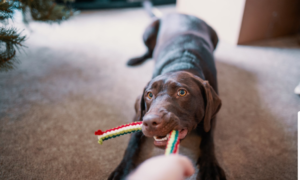The most important thing you can do for your dog during a house move is to keep their routine consistent and help to keep them stress-free.
Here are some do’s and don’ts for moving with your dog.
Moving House with Your Pet (The Do’s!)
1) Keep their routine as consistent as possible, including meals and walking times. Whilst everything else around them is changing, it’s important that the core of their day stays the same so that they have some consistency.
2) Leave all of their belongings out just up until you’re about to move. This will ensure that they have all of their familiar things around them, and will also keep them entertained while you are busy boxing everything up and loading the moving van.
3) Limit them to one room while the move is taking place, both in the old house and the new house. There will be a lot going on during the move, so to make sure they stay safe, shut them in one room and check they’re OK once every hour or so.
4) Make sure you have a new ID tag and collar for them, which you can put on during the day of the move. Alternatively, you can add two tags to their collar during the move so it has both your old address and current address.
5) When you arrive at your new home, only give them access to one room and spend an hour or so with them to help them settle in. When you have to go and unpack, leave them with their familiar toys and bed.
Moving House with Your Pet (The Don’ts!)
1) Don’t put your dog in daycare during the day of the move. They will have already sensed that something huge is about to happen in the few day build up to the house move, and anything that happens outside of the ordinary right now will put them on edge. Keep them with you so they don’t feel abandoned.
2) Don’t buy them loads of new toys or a new bed for the first few weeks. They will be glad of the familiarity and the smell of their old things and this will help them to settle into the new house. You can treat them after a few weeks of living in your new place.
3) Don’t punish them for any aggressive behaviors. It is likely that your dog might start to display some unwanted behaviors such as chewing or having accidents in the house. This move will have been stressful for them, so go easy and just redirect any behaviors which aren’t acceptable.
4) Don’t let them explore the whole house and back yard until you have checked that it is totally safe. Check that all the fences are secure and there is no escape route for them.
5) Don’t let them off the leash for the first few times that you walk them around your new area. Give them some time to adjust to the local sights and smells, because if they run off it’s unlikely they will be able to find their way back to you.
Summary
Your dog will need to rely on you to help them remain calm and enjoy the move process. Try to stick to their regular meal and walking times to ensure that they have some consistency in their lives while they are getting used to their new surroundings.
If they are really stressed, you can exercise and walk them more, or create a safe zone in the new house which is just for them.
Author Bio: Thomas Woods is the creator of Perfect Dog Breeds, an educational website where he shares his expertise of training and caring for dogs. Thomas has had dogs for as long as he can remember and has helped thousands of people to train their perfect breed.



